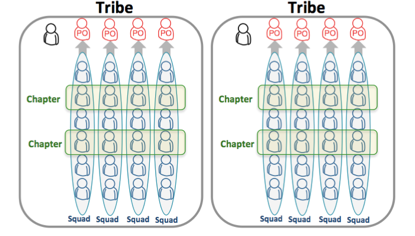Posted on December 8, 2015
Example of agile culture ? Look at how Spotify works..
The concept of culture stems from the discipline of anthropology and sociology (Hatch, 1993). After the mid-1970s, an organisational sociologist realised there was a lack of understanding between organisational goals and actual outcomes. This gap raised interest in the concept of organisational culture. (Ouchi and Wilkins, 1985)
Amongst plenty of definitions, three dominant characteristics can describe the concept of organisational culture (Wilson, 1996). Firstly, culture is a shared phenomenon. Culture is seen as an array of social or normative dispositions that are shared by a given group and holds together diverse members (Schein, 1985). In a corporate scenario, the group might be the whole organisation or a subgroup. Secondly, culture expresses two levels: the surface level and the deeper level. The surface level comprises elements such as detectable patterns of behaviour shown by the group and physical artefacts, such as buildings. The deeper level of culture refers to the values that the group shares and the behavioural context set up by the members (Wiener, 1988). Thirdly, culture is learned. In an organisation scenario while a group assembles, culture often plays as the catalyst that gathers people in creating a sense of identity and belonging. (Dawson and Andriopoulos 2014)
Example of agile culture is at Spotify. It currently provides digital music streaming to 15 million paying users, and 60 million subscribers. Henrik Kniberg and Anders Ivarsson were in charge of the product development in the organisation in which at that time it counted over 30 teams across three cities in October 2012.
At Spotify the basic unit of development is the ‘squad’. It acts as a mini start-up applying principles such as MVP (Minimum Viable Product). It means releasing early and often. Each squad has skills and tools to design, develop, test and release to production. During the mission each squad develop expertise as they spend long time on the project.
To encourage learning and innovation the squad are allowed to spend almost 10% of their time on “hack days”. During this time people are free to experiment on whatever they want and share with their peers. A squad has a product owner, not a squad leader. They oversee the work priorities with no involvement in running the project.
Autonomy is one of the main values of this approach. A ‘tribe’ is an array of squads that work in linked areas. The tribe can be described as “the incubator” for the mini start-ups. Each tribe has a tribe lead who is charge for creating the best environment for the squads within the tribe. To avoid bureaucracy, politics and useless management practice the tribes’ capacity follows the “Dunbar number” concept. Most people cannot sustain a social relationship with more than 100 people or so. Therefore tribes are smaller than 100 people.
Scaling Agile @Spotify – Tribes
The two areas of development and operation are quite often related to dependency issues. At Spotify there is a separate operations team that supports the different squads and they play an important role throughout the production. Instead of creating a detailed process documentation they boost effective collaboration through face-to-face communication.
In a full autonomy culture, the drawback is a loss of economies of scale as Spotify essentially act as a bunch of small companies. ‘Chapters’ and ‘guilds’ show economies of scale as much as they keep the autonomy up.
The chapter is a cluster of people with complementary skills within the same expertise area, just like a tribe. The chapter lead is a line manager with the common responsibilities, such as developing people, setting salaries. He or she is also engaged with the squad to balance out the routine with ad-hoc projects.
A guild is a flexible organic “community of interest” where a group of peers share knowledge, ideas and tools. Chapters are always connected to a tribe whereas a guild moves across the organisation. An example is the coach of a guild. The coaches deliver knowledge consistently all over the organisation. They hold meetings to foster the organisation’s understanding and its improvement. These steps are carefully tracked on an improvement board.
Scaling Agile @Spotify – Tribe and Guild
Generally the matrix organisations see people gathered with certain skills into functional departments, they are “assigned” to projects, and “report to” a functional manager. Spotify are different – they focus on delivery.
Scaling Agile@ Spotify – Matrix
The vertical dimension in the matrix depicts how people are placed and where they spend their time. The horizontal dimension spurs the collaborative attitude. The chapter lead’s task is to nourish this flow of activities. The matrix structure guarantees that each squad member is guided to his or her own development.
The product owner is the “entrepreneur” focusing on delivering a product whereas the chapter leader is the “competency leader”, focusing on technical excellence. There is a motivating tension between these roles. The first tends to rush the process, the second wants to ponder the steps to reach a proper outcome. Both are necessary to build a “healthy” tension.
Scaling Agile @Spotify – Alignment




